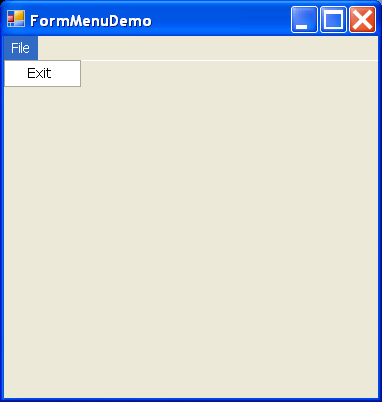Form Menu

/*
C# Programming Tips & Techniques
by Charles Wright, Kris Jamsa
Publisher: Osborne/McGraw-Hill (December 28, 2001)
ISBN: 0072193794
*/
using System;
using System.Drawing;
using System.Collections;
using System.ComponentModel;
using System.Windows.Forms;
using System.Data;
namespace FormMenu
{
/// <summary>
/// Summary description for FormMenuDemo.
/// </summary>
public class FormMenuDemo : System.Windows.Forms.Form
{
private System.Windows.Forms.MainMenu mainMenu1;
private System.Windows.Forms.MenuItem mnuFile;
private System.Windows.Forms.MenuItem mnuFileExit;
/// <summary>
/// Required designer variable.
/// </summary>
private System.ComponentModel.Container components = null;
public FormMenuDemo()
{
//
// Required for Windows Form Designer support
//
InitializeComponent();
//
// TODO: Add any constructor code after InitializeComponent call
//
}
/// <summary>
/// Clean up any resources being used.
/// </summary>
protected override void Dispose( bool disposing )
{
if( disposing )
{
if (components != null)
{
components.Dispose();
}
}
base.Dispose( disposing );
}
#region Windows Form Designer generated code
/// <summary>
/// Required method for Designer support - do not modify
/// the contents of this method with the code editor.
/// </summary>
private void InitializeComponent()
{
this.mainMenu1 = new System.Windows.Forms.MainMenu();
this.mnuFile = new System.Windows.Forms.MenuItem();
this.mnuFileExit = new System.Windows.Forms.MenuItem();
//
// mainMenu1
//
this.mainMenu1.MenuItems.AddRange(new System.Windows.Forms.MenuItem[] {
this.mnuFile});
//
// mnuFile
//
this.mnuFile.Index = 0;
this.mnuFile.MenuItems.AddRange(new System.Windows.Forms.MenuItem[] {
this.mnuFileExit});
this.mnuFile.Text = "&File";
//
// mnuFileExit
//
this.mnuFileExit.Index = 0;
this.mnuFileExit.Text = "E&xit";
this.mnuFileExit.Click += new System.EventHandler(this.mnuFileExit_Click);
//
// FormMenuDemo
//
this.AutoScaleBaseSize = new System.Drawing.Size(5, 13);
this.ClientSize = new System.Drawing.Size(292, 273);
this.Menu = this.mainMenu1;
this.Name = "FormMenuDemo";
this.Text = "FormMenuDemo";
}
#endregion
/// <summary>
/// The main entry point for the application.
/// </summary>
[STAThread]
static void Main()
{
Application.Run(new FormMenuDemo());
}
private void mnuFileExit_Click(object sender, System.EventArgs e)
{
Application.Exit ();
}
}
}
Related examples in the same category